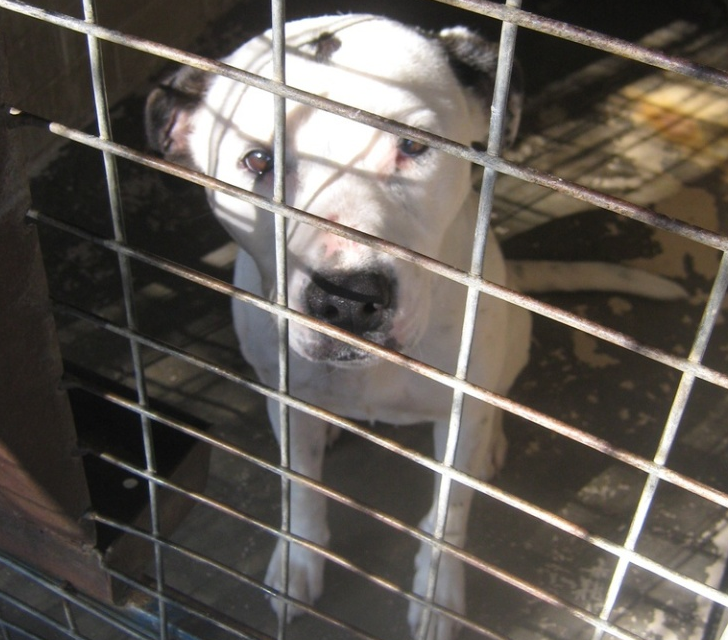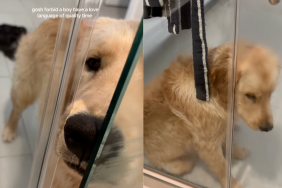by Leslie Smith, DogTime editor
August 2010
A huge gray Pit Bull arrived as a stray at the shelter last week. Her ears were cropped, jagged and sloppily, so you know the job was done with scissors in someone’s yard. A long, unsightly acid burn stretched all the way down her back — another common practice intended to make a dog look tough — the streak now scabby and furless.
By law, she was confined to her kennel for seven days, so for that week, I sat on the other side of the cage bars, playing games and tossing her treats. But by the following Tuesday, the shelter behaviorist had evaluated her and granted me permission to take her for a walk. The dog was big and strong and had probably never in her life walked on a leash. She pulled me around for about ten minutes, before I (overpowered) managed to return her to her kennel.
I decided that on my next shift, I’d take the gray Pit out first thing — that way, I’d have enough energy to give her a decent walk. Friday I went straight to the dog’s kennel, but when I got there, her door was open. I ran to the euthanasia room and, breaking all established protocol procedures, knocked on the door.
“Is the gray Pit already gone?” I asked when the vet tech opened the door.
“No, I just tranquilized her. She’s still woozy,” he said.
“Can I say goodbye?”
He nodded and left us alone in the room.
At this point, she could barely lift her head, but her eyes were open and I laid down with her, spoon style, and cooed and petted her. After a minute or so, she started convulsing. A small number of dogs (but not so small that I’d never seen it before) react this way to the tranq. As her head shook, the heavy metal chain around her neck clinked against the cement floor. So, with one hand I held the chain up off the floor and with the other I cupped the her head. Her eyes were still open.
After a few minutes, the vet tech returned. I asked if I could stay and hold her while he administered the lethal injection, but he said no. (Some techs allow me to stay, others don’t.) So I left the dog, still convulsing, to die on a cement floor, a stranger shooting poison into her vein. I wondered if when she saw the vet tech coming toward her kennel with a leash, she thought she was going for a walk again. Instead she was led to a tiny room, drugged, and killed.
¤¤¤¤¤
The gap between what shelters are doing and what they need to be doing: Is it conquerable?
Nathan Winograd, the prominent animal welfare thinker who literally wrote the book (two, actually) on the No Kill movement, asserts there’s a nationwide dearth of competent, dedicated leadership in our shelter systems. At one time, I would’ve whole-heartedly disagreed with him. At each and every facility I’ve worked in, I’ve witnessed tremendous sacrifice and incredible devotion.
But the longer I’ve volunteered and the more hours I’ve put in, the less convinced I’ve become that we — the shelter — are doing all we can in an overwhelmingly difficult situation. Outstanding efforts are made, at times, but they aren’t the norm. Shelter policies (often created by municipal bodies outside the animal welfare arena) aren’t deliberately cruel, but often are not in the animals’ best interest. And the lack of true leadership isn’t blatant, but its absence takes a toll at every level of shelter management.
Over ten years, I’ve begun to see room for improvement. Lots and lots of room.
Who’s to blame? Everyone.
Not the least of our troubles in overcoming this crisis: People are human. We put ourselves or our families or our financial stability above all else. Can you blame us? How do you fault someone for being a parent or spouse or friend first, shelter administrator second?
So part of the challenge is prioritization. But even among those for whom animal welfare is paramount, fixing the system is far from easy. Case in point: me. I’m passionate and dedicated and consider animal welfare my ultimate purpose. I’m educated and I have experience with many aspects of shelter life. But there’s no way I could successfully run one. I simply don’t have the skill set.
Endless fundraising, overseeing daily operations, maintaining a reliable volunteer and foster base, and working with government-funded animal control is just the beginning. All this as fiscal support declines, and shelters are asked to do more with less. It’s not a task for the somewhat skilled or the B+ worker. We need organized, uber-competent, development-minded rock stars.
In most communities, however, fundraising wizards with endless energy, incredible leadership skills, charm, experience, and an MBA aren’t just sitting around waiting to be hired by their local animal shelter. That doesn’t mean current administrators aren’t trying their best or giving all they have — it just means their best isn’t good enough. There are very few people (myself included) with the precise combination of skills and education who would succeed.
Meanwhile, the animals keep coming and coming and coming. Many need medical attention. All need food, water, and clean cages. And if you want to get the animals adopted — not to mention, run a humane institution — all need mental and physical exercise, socialization, attention, and training.
A shelter is no place for an animal
Shelter life is extremely stressful for a dog — more on that later. Yet in order to offer a selection of animals who are attractive (read: manageable) enough to compete with what breeders’ offer, we have to ensure our animals get sufficient care and attention that they remain easy-going, polite, healthy. And that requires a significant amount of time for each animal, every day. In the majority of counties around the country, running a shelter is more than a full-time job, it’s a life.
So where once I was offended by Winograd’s assertions about shelter management, I now find myself agreeing that there simply aren’t enough qualified people in positions of shelter leadership. What’s more, there aren’t enough tax-payer dollars or private donations to do this right. Our shelters desperately need help. For open admissions, No Kill facilities to become the norm, a lot of people have to want it badly. And a significant portion of those must be willing to work for it.
Next installment: Adoption is not the best solution
Read previous installment: People love pets — as long as they’re convenient.
Read next installment: Adoption will not end the suffering
Read all installments.









